
The original Yankee Stadium was located in the Bronx in New York City. It was the home of the New York Yankees from 1923 to 2008, except for 1974–1975 when it was renovated. It hosted 6,581 Yankees regular season home games during its 85-year history. It was also the home of the New York Giants National Football League (NFL) team from October 21, 1956 through September 23, 1973. The stadium's nickname is "The House That Ruth Built" which is derived from Babe Ruth, the baseball superstar whose prime years coincided with the stadium's opening and the beginning of the Yankees' winning history.

The Polo Grounds was the name of three stadiums in Upper Manhattan, New York City, used mainly for professional baseball and American football from 1880 to 1963. The original Polo Grounds, opened in 1876 and demolished in 1889, was built for the sport of polo. Bound on the south and north by 110th and 112th streets and on the east and west by Fifth and Sixth (Lenox) avenues, just north of Central Park, it was converted to a baseball stadium when leased by the New York Metropolitans in 1880.

Ebbets Field was a Major League Baseball stadium in the Flatbush section of Brooklyn, New York. It is mainly known for having been the home of the Brooklyn Dodgers baseball team of the National League (1913–1957). It was also home to five professional football teams, including three NFL teams (1921–1948). Ebbets Field was demolished in 1960 and replaced by the Ebbets Field Apartments, the site's current occupant.

Sportsman's Park was the name of several former Major League Baseball ballpark structures in St. Louis, Missouri. All but one of these were located on the same piece of land, at the northwest corner of Grand Boulevard and Dodier Street, on the north side of the city.
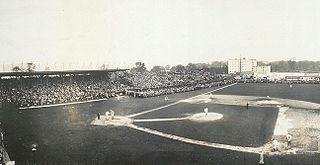
Hilltop Park was a ballpark in the Washington Heights neighborhood of Manhattan in New York City. It was the home of the New York Yankees of Major League Baseball from 1903 to 1912 when they were known as the "Highlanders". It was also the temporary home of the New York Giants during a two-month period in 1911 while the Polo Grounds was being rebuilt after a fire.
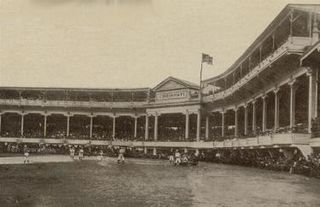
Palace of the Fans was a Major League baseball park located in Cincinnati, Ohio. It was the home of the Cincinnati Reds from 1902 through 1911. The ballpark was on an asymmetrical block bounded by Findlay Street (south), Western Avenue, York Street (north) and McLean Avenue (west).
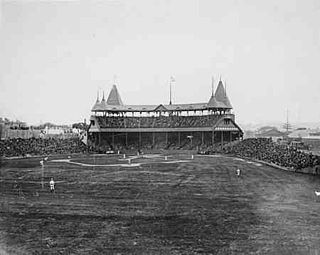
South End Grounds refers to any one of three baseball parks on one site in Boston, Massachusetts. They were home to the franchise that eventually became known as the Boston Braves, first in the National Association and later in the National League, from 1871 through part of the 1914 season. That stretch of 43 1/2 seasons is still the longest tenure of the Braves club at any of their various ballparks and cities since 1914.
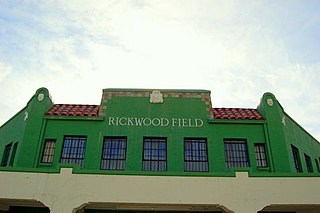
Rickwood Field, located in Birmingham, Alabama, is the oldest existing professional baseball park in the United States. It was built for the Birmingham Barons in 1910 by industrialist and team-owner Rick Woodward and has served as the home park for the Birmingham Barons and the Birmingham Black Barons of the Negro leagues.

Sulphur Dell, formerly known as Sulphur Spring Park and Athletic Park, was a baseball park in Nashville, Tennessee, United States. It was located just north of the Tennessee State Capitol building in the block bounded by modern-day Jackson Street, Fourth Avenue North, Harrison Street, and Fifth Avenue North. The ballpark was home to the city's minor league baseball teams from 1885 to 1963. The facility was demolished in 1969.

Owen J. Bush Stadium was a baseball stadium in Indianapolis, Indiana, United States. It was home to the Indianapolis Indians from 1931 to 1996. It was also home to a few Negro league teams, as well as a Continental Football League team, the Indianapolis Capitols, who won the league's final championship in 1969.

A ballpark, or baseball park, is a type of sports venue where baseball is played. The playing field is divided into two field sections called the infield and the outfield. The infield is an area whose dimensions are rigidly defined in part based on the placement of bases, and the outfield is where dimensions can vary widely from ballpark to ballpark. A larger ballpark may also be called a baseball stadium because it shares characteristics of other stadiums.

Dwyer Stadium is a 2,600 capacity stadium in Batavia, New York, situated in Genesee County. It opened in 1996 replacing the original stadium that was built in 1937, while the playing field is the original. The stadium is currently home to the Batavia Muckdogs of the Perfect Game Collegiate Baseball League, a collegiate summer baseball league; the Genesee Community College Cougars of the National Junior College Athletic Association (NJCAA); and high school teams including the Notre Dame of Batavia Fighting Irish and Batavia Blue Devils.

Al López Field was a spring training and Minor League baseball ballpark in West Tampa, Tampa, Florida, United States. It was named for Al López, the first Tampa native to play Major League Baseball (MLB), manage an MLB team, and be enshrined in the Baseball Hall of Fame. Al López Field was built in 1954 and hosted its first spring training in 1955, when the Chicago White Sox moved their training site to Tampa from California. Al López became the White Sox's manager in 1957, and for the next three springs, he was the home manager in a ballpark named after himself. The Cincinnati Reds replaced the White Sox as Al López Field's primary tenant in 1960 and would return every spring for almost 30 years. The Tampa Tarpons, the Reds' Class-A minor league affiliate in the Florida State League, played at the ballpark every summer from 1961–1987, and many members of the Reds' Big Red Machine teams of the 1970s played there early in their professional baseball careers.
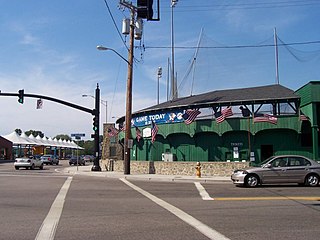
Cardines Field is a baseball stadium located at 20 America’s Cup Avenue in Newport, Rhode Island. It is believed to be one of the oldest ballparks in the United States and has been called "a small urban gem of a ballpark". The field serves as a buffer between the residential and commercial sections of an older part of Newport. The oddly shaped outfield fence and dimensions are created by the close proximity of residential housing, while the spectator side of the park is contained by America's Cup Avenue and West Marlborough Street. Originally called Basin Field, references to the field can be found as early as 1893. At that time, the property was used by local railroads as a drainage and supply basin for steam engines. Complaints from neighbors about the stagnant water and mosquitoes prompted the drainage of the basin area, permitting baseball to be played. A local historical debate continues as to whether baseball was played prior to 1900, making Cardines one of the oldest existing ballparks in the country, or if play didn't begin until 1908, the earliest documented proof of stadium construction.

J. P. Small Memorial Stadium is a baseball park in Jacksonville, Florida. It is located in the Durkeeville community in northwest Jacksonville. Constructed in 1912 and rebuilt in 1936, it was the city's first municipal recreation field, and served as its primary baseball park before the construction of Wolfson Park in 1954. Throughout the years the stadium has been known at various times as Barrs Field, Durkee Field, and the Myrtle Avenue Ball Park.

Yankee Stadium is a baseball stadium located in the Bronx in New York City. It is the home field of Major League Baseball’s New York Yankees and New York City FC of Major League Soccer.

West End Park was a baseball park in Houston from 1905 to the 1940s. It was the primary ballpark for the city when it was constructed, and the city's first venue for Negro Major League games. From 1909 through 1910 and again in 1915, it also served as the spring training facility of the St. Louis Browns as well as the 1914 New York Yankees of the American League and the 1906 through 1908 St. Louis Cardinals of the National League in Major League Baseball. After its use by its primary tenant, the Houston Buffaloes of the Texas League, the ballpark was sold to what is now known as the Houston Independent School District for its use until it was demolished.
The Manchester Yankees was the name of two distinct American minor league baseball franchises representing Manchester, New Hampshire, in the Class B New England League and the Double-A Eastern League (1969–71). Each franchise played at Gill Stadium and each was affiliated with Major League Baseball's New York Yankees.
The Manchester Blue Sox were a minor league baseball team based in Manchester, New Hampshire. From 1926 to 1930, the Blue Sox played as members of the Class B level New England League, winning the 1926 and 1929 league championships.



















